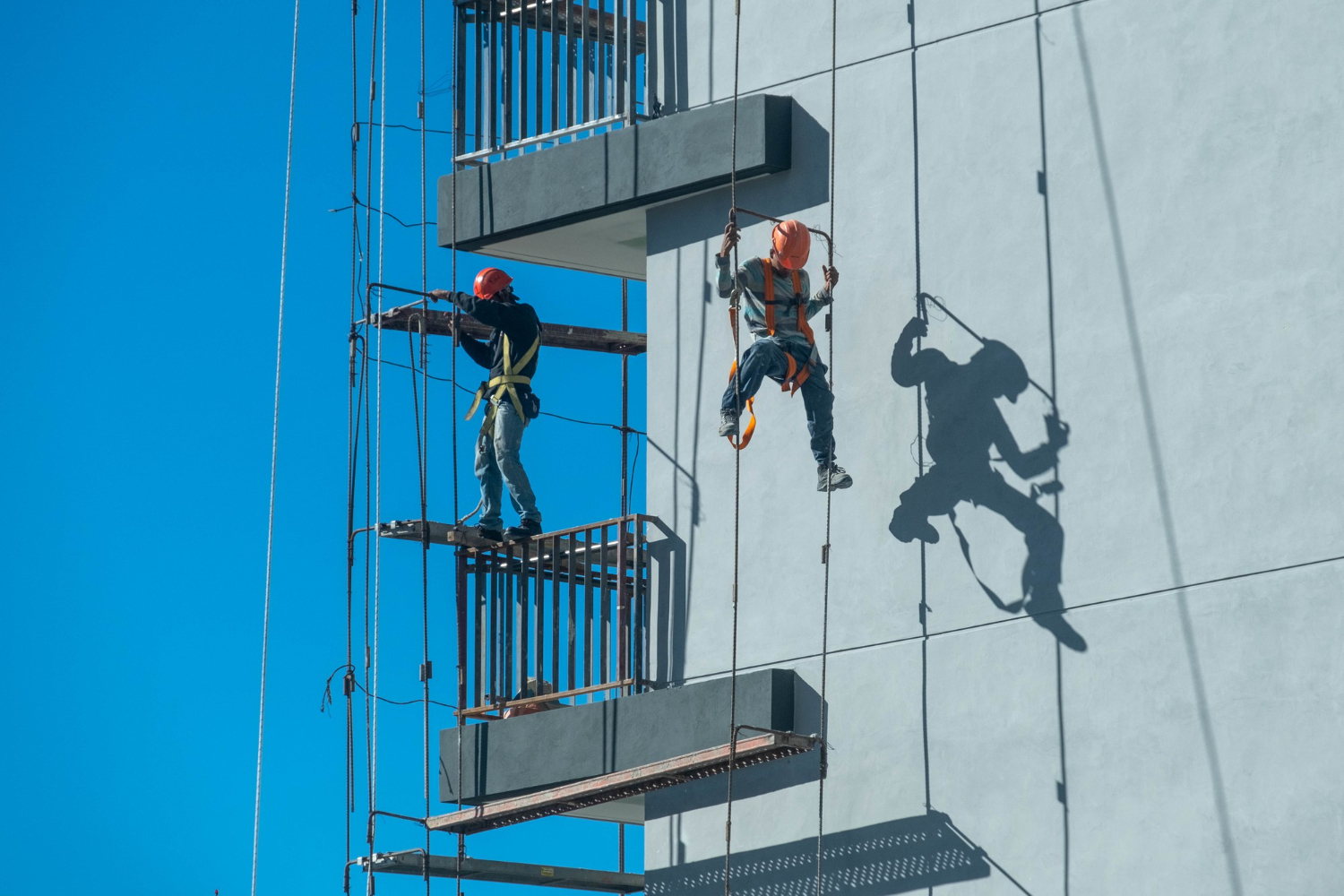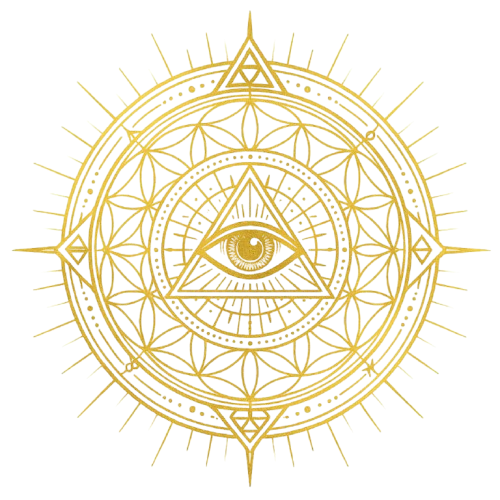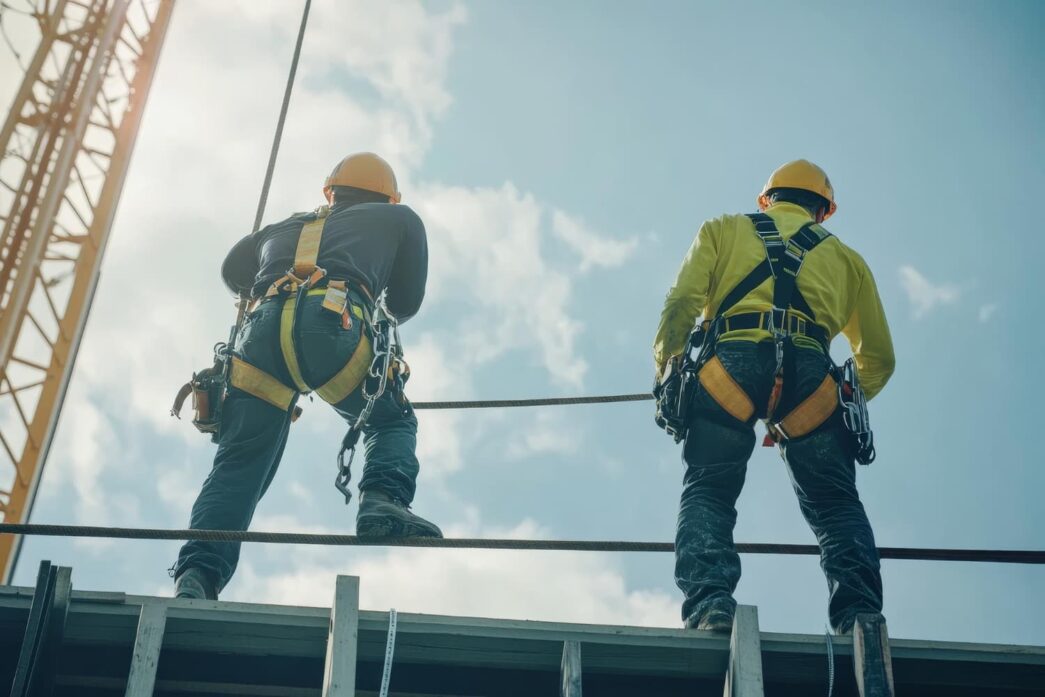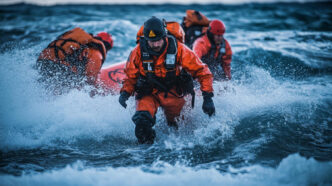Technical Name: TRAINING COURSE NR 35 – SAFETY IN WORK AT HEIGHT – WORKER LEVEL
Reference: 10044
We offer courses and training in technical language: Portuguese, English (Regional), Croatian, Japanese, Spanish, French, Chinese (Regional), German, India (Regional), Arabic, Korean, Russian, among others.
What Is the Purpose of the NR 35 Training Course?
The NR 35 – Work at Height Safety Training Course primarily aims to qualify workers to safely and responsibly perform any activity carried out above two meters from the lower level, whenever there is a risk of falling. Therefore, the training goes beyond simply conveying regulatory content: it seeks to develop technical competence, risk perception, and preventive conduct based on real field situations.
Initially, the course introduces the requirements of NR 35. As it progresses, however, it guides participants through the practical internalization of fundamental procedures, such as:
Selecting, adjusting, and correctly using Personal Protective Equipment (PPE);
Interpreting and executing Preliminary Risk Analysis (PRA);
Applying collective and individual control measures;
Responding safely in emergency scenarios, including basic rescue techniques.
Furthermore, the course fully complies with subitems 35.3.1 to 35.3.8 of NR 35, ensuring that, by the end of the process, the worker is not only aware of what must be done but is also formally trained, evaluated, and certified according to the legal and occupational safety standards.

Work at Height Safety Course: What Are the Most Common Mistakes in PPE Selection and How to Avoid Them?
Selecting the correct PPE for work at height goes far beyond choosing what “seems appropriate.” It requires technical analysis, compliance with standards, and a realistic understanding of the operational context.
Even in environments where formal training is provided, some errors persist, often due to habit, haste, or overconfidence.
Here’s a table summarizing the most frequent mistakes, their direct consequences, and the technical corrections based on applicable standards:
| Common Mistake | Consequence | Technical Correction (Based on Standards) |
|---|---|---|
| Generic PPE selection | Incompatibility with the actual risk type | Assess technical specifications based on ABNT NBR 16489 |
| Failure to check the CA (approval) | Legally invalid PPE | Verify validity on the Brazilian Ministry of Labor website; document delivery |
| Improper adjustment of PPE | Risk of fall due to slippage or detachment | Provide hands-on training for correct fitting |
| Not considering the complete system | Incompatibility with connectors/anchorage | Design the PPE as an integrated protection system |
| Worn or expired PPE | Loss of resistance; risk of equipment failure | Implement a pre-use and periodic inspection routine, with records |
In summary, PPE selection demands technical knowledge, ongoing inspection, and a genuine commitment to safety. No equipment protects on its own — its effectiveness depends on conscious and system-oriented use.
Why Is Perceptive Behavior Critical When Working at Height?
Perceptive behavior refers to the worker’s active ability to identify, anticipate, and respond to risk signals in real time, even before they manifest as operational failures or accidents.
With consistent training and field exposure, the worker sharpens their perception and begins to detect subtle environmental changes, such as abnormal displacements, unusual sounds, sudden weather shifts, or unsafe behavior from others. This type of conscious, intentional attention acts as an extension of the protection systems, boosting vigilance and reducing reaction time.
Therefore, developing perceptive behavior is not optional it is a strategic risk control mechanism under NR 01 (GRO/PGR) and NR 35.
Why Is Routine Exposure One of the Greatest Hidden Threats in Work at Height?
Operational familiarity creates an illusion of safety. When a worker performs the same task repeatedly without incident, the brain gradually lowers its guard. This process, known as risk habituation, causes workers especially the experienced ones, to overlook critical steps and warning signs.
Consequently, periodic training and behavioral reinforcement become essential, as required by NR 35.3.3, to interrupt this cycle and restore the worker’s state of alertness.

What Criteria Should Guide the Choice Between Fall Arrest, Work Positioning, or Restraint Systems?
According to NR 35, ABNT NBR 16489, and ABNT NBR 16325, the proper system must be selected based on task type, risk level, structure, and fall clearance. See the table below:
| System | When to Use | Purpose |
|---|---|---|
| Restraint | When physical means can prevent access to the fall hazard zone | To prevent exposure to the fall risk area |
| Positioning | When stability is required to work with both hands | To allow stable access and postural control |
| Fall Arrest | When a fall cannot be prevented entirely | To contain and minimize injury upon a fall |
Thus, the system must be selected based on a Preliminary Risk Analysis (PRA) and consider available fall clearance, structure type, and shock absorption needs. The goal is smart prevention, not mere regulatory compliance.
What Is the Relationship Between Task Time Management and Safety in Work at Height?
Effective time management balances productivity with prevention. When workers are pressured to meet deadlines without sufficient time for planning, installation of protections, or risk analysis, the likelihood of critical errors increases significantly.
According to NR 01 (PGR) and NR 35, time allocation must include:
Risk analysis and PRA
PPE inspection
Installation of collective protection systems
Team communication and monitoring
Well-structured time planning ensures that safety becomes part of the operational flow, not a delay.
Why Doesn’t the Mere Presence of PPE Guarantee Safety?
Because safety lies in the correct and consistent use of the equipment, not just its presence. A harness, for instance, only protects if it’s properly adjusted, securely connected to a certified anchorage point, and free from defects.
Both NR 06 and NR 35 require not just the delivery of PPE but also practical training, usage documentation, and periodic evaluations. In this sense, safety is an ongoing action — not a decorative formality.

How Can Communication Failure Be a Primary Cause of Accidents at Height?
In high-risk environments like work at height, communication is not a minor factor, it is the invisible infrastructure of safety. A misunderstood command, a missing signal, or a silent radio can turn a controlled activity into a high-risk situation.
Unlike other workplaces, where errors can often be corrected in real time, in height work reaction time is the boundary between prevention and accident.
The most common failures include:
Unvalidated verbal commands
Absence of visual protocols in noisy areas
Mismatch between operators and spotters
Lack of pre-task radio checks
Improvised or missing signage
Thus, both NR 01 (subitem 1.5.3.3) and ISO 45001 (item 7.4) emphasize the need for formal, clear communication protocols, especially in interdependent tasks with fall risk.
You’ve Mastered the Task… So Reviewing the PRA Daily Might Seem Redundant — Or Is It?
At first glance, reviewing the Preliminary Risk Analysis (PRA) daily may seem repetitive, especially for experienced workers. Familiarity with the task often creates a false sense of stability, as if the conditions remain unchanged.
However, this perception overlooks a critical truth: risk evolves with each new variable introduced into the environment.
For example:
Today’s wind is not the same as yesterday’s;
The colleague nearby may be fatigued;
The scaffolding that was secure yesterday may now be compromised;
The anchorage point may have been altered.
In reality, reviewing the PRA daily is not bureaucracy it’s operational intelligence. It reflects the understanding that experience doesn’t neutralize risk; it enhances the responsibility to recognize it earlier.
See Also:
Curso NR 35 Inglês
Ensaio Destrutivo em Sistema de Ancoragem
Curso NR 35 em Inglês
Certificado de conclusão
Safety Course in Work at Height NR 35
TRAINING COURSE NR 35 – SAFETY IN WORK AT HEIGHT – WORKER LEVEL
Duration: 08 Hours
Module 1 – (1 Hora)
Applicable standards and regulations for work at height
Module 2 – (1 Hora)
Preliminary Risk Analysis and prohibitive conditions
Module 3 – (1.5 Hora)
Potential hazards in work at height and preventive and control measures
Module 4 – (1.5 Hora)
Collective protection systems, equipment, and procedures
Module 5 – (1 Hora)
Personal Protective Equipment (PPE) for work at height: selection, inspection, maintenance, and use restrictions
Module 6 – (1 Hora)
Typical accidents in work at height
Module 7 – (1 Hora)
Emergency procedures, including basic rescue techniques and first aid
Course Completion and Certification:
Practical Exercises
Evidence Recording
Theoretical Assessment
Practical Assessment (when contracted)
Certificate of Participation
Observation:
This program content complies with the NR 35 standard and aims to ensure that workers can safely perform activities at height, with the necessary knowledge to prevent accidents and maintain a protected work environment.
Note:
The General Program Content of the Course or Training may be modified, updated, expanded, or reduced as necessary by our Multidisciplinary Team. This team has full authority to revise, adapt, or exclude content, as well as to include or remove standards, laws, decrees, or technical parameters deemed applicable—whether directly related or not. The Client is responsible for ensuring compliance with the relevant legislation.
Our Multidisciplinary Team is entitled to insert the standards, laws, decrees, or technical parameters that they deem applicable, whether related or not to the scope of service negotiated, with the Contracting Party being responsible for providing the necessary services in accordance with the legislation, as established in them.
Safety Course in Work at Height NR 35
Safety Course in Work at Height NR 35
Participants without experience:
Minimum working load = 08 hours/class
Participants with experience:
Minimum working load = 08 hours/class
Update (Recycle):
Minimum working load = 08 hours/class
35.3.3 The employer must conduct biennial periodic training and whenever any of the following situations:
a) change in the procedures, conditions or operations of job;
b) event that indicates the need for new training;
c) return to work for more than ninety days;
d) change of company.
Certificate: The Certificate will be issued for each participant that achieves the minimum use of 70% (theoretical and practical) as recommended by the Regulatory Standards.
Safety Course in Work at Height NR 35
Safety Course in Work at Height NR 35
Normative references when applicable and their updates:
NR 01 – Disposições Gerais e Gerenciamento de Riscos Ocupacionais – (General Provisions and Occupational Risk Management);
NR 06 – EPI (Equipamento de Proteção Individual) – (Personal Protective Equipment – PPE);
NR 35 – Trabalho em Altura (Work at Height);
ABNT NBR 16489 – Sistemas e equipamentos de proteção individual para trabalhos em altura – Recomendações e orientações para seleção, uso e manutenção (Individual protection systems and work at height equipment – Recommendations and guidelines for selection, use and maintenance);
ABNT NBR 16325-1 – Proteção contra quedas de altura – Parte 1: Dispositivos de ancoragem tipos A, B e D – (Protection against falls from a height – Part 1: Type A, B and D anchoring devices);
ABNT NBR 16325-2 – Proteção contra quedas de altura – Parte 2: Dispositivos de ancoragem tipo C – (Protection against falls from a height – Part 2: Type C anchoring devices);
ABNT NBR 16746 – Segurança de máquinas – Manual de Instruções – Princípios gerais de elaboração (Machine safety – Instruction Manual – General principles of elaboration);
ABNT NBR 16710-1 Resgate técnico industrial em altura e/ou em espaço confinado – Parte 1: Requisitos para a qualificação do profissional – (Industrial technical rescue at height and/or in confined space – Part 1: Professional qualification requirements);
ABNT NBR 16710-2 Resgate Técnico Industrial em Altura e/ou em Espaço Confinado – Parte 2 Requisitos para provedores de Treinamento e Instrutores para qualificação Profissional – (Industrial Technical Rescue at Height and/or Confined Space – Part 2 Requirements for Training Providers and Instructors for Professional Qualification);
Protocolo – Guidelines American Heart Association;
ISO 45001 – Sistemas de gestão de saúde e segurança ocupacional – Requisitos com orientação para uso (Occupational health and safety management systems – Requirements with guidance for use);
Note: This Service exclusively meets the requirements of the MTE (Ministry of Labor and Employment) when dealing with other bodies, inform in the act of request.
Safety Course in Work at Height NR 35
Safety Course in Work at Height NR 35
What is the importance of conducting the nr 35 – safety in work at height training course in the worker’s native language?
Delivering the NR 35 – Safety in Work at Height Training Course in the worker’s native language is essential to ensure the effectiveness of the training, operational safety, and legal compliance. When the content is fully understood, the worker performs procedures correctly, identifies risks, and adopts preventive measures assertively.
Furthermore, the legislation requires actual training, which implies full understanding of the information provided. Courses delivered in languages not mastered by the worker compromise the validity of the training and significantly increase the risk of accidents, with possible legal consequences for the company.
Using the native language also improves performance in evaluations, facilitates learning of technical terms, and strengthens the safety culture and team engagement.
Our pedagogical project follows the guidelines imposed by Regulatory Standard nº1.
After payment is made, Purchase Order, Contract signed between the parties, or other form of closing confirmation, the teaching material will be released within 72 working hours (up to 9 days), due to the adaptation of the syllabus and compliance with the Standards Techniques applicable to the scenario expressed by the Contracting Party; as well as other adaptations to the teaching material, carried out by our Multidisciplinary Team for technical language according to the student’s nationality and Technical Operational and Maintenance Instruction Manuals specific to the activities that will be carried out.
Attention: The Course teaches you to apply the normative concepts of the standard, which enables you to sign Projects, Reports, Expertise etc. these are the duties that the Legally Qualified Professional has with his Class Council, for example, CREA. This course aims to study situations where it will be necessary to apply: Concepts and Calculations according to the relevant Standards and does not replace the analysis and responsibility on the part of each professional accredited with CREA or other Class Councils in the most varied situations, where makes it absolutely necessary to respect the conditions of conservation of the equipment, periodic checking of the instruments, as well as the respect of primary capacity pre-determined by the PPE manufacturers, among others based on the corresponding Norms.
LAW No. 5,194, OF 24 DEC 1966 – CONFEA:
“Section III
Illegal Exercise of Profession
Art. 6 – Is illegally practicing the profession of engineer, architect or agronomist:
a) the natural or legal person who performs acts or provides services, public or private, reserved for the professionals referred to in this Law and who does not have registration with the Regional Councils:
b) the professional who undertakes activities that are foreign to the attributions described in his record;
c) the professional who lends his name to people, firms, organizations or companies executing works and services without his real participation in their work;
d) the professional who, suspended from his practice, continues to work;
e) the firm, organization or company that, as a legal entity, performs duties reserved for professionals in Engineering, Architecture and Agronomy, in violation of the provisions of the sole paragraph of Article 8 of this Law.”
OTHER ELEMENTS WHEN APPLICABLE AND CONTRACTED:
A) Standards and applicable work at height regulations;
B) Risk analysis and impeding conditions of work at height;
C) Potential inherent risks in working at heights and measures of prevention and control;
D) collective protection systems, equipment and procedures;
E) Individual Protection Equipment for working at heights: selection, inspection, conservation and use limitation;
F) Typical accidents in work at height;
G) Emergency situations conducts, including notions of rescue techniques and first aid in working at heights;
A) Change in procedures, conditions or work operations;
B) Event that indicates the need for new training;
C) Return to work for a time period bigger than ninety days;
D) Change of company;
Practical Exercises;
Perception Risk and Facts inflicted on people;
Safety Impact and Behavior Facts;
Fear Factor;
Risk Habituation and Consequences;
The matter and of task knowledge;
Knowledge of Ergonomic;
Work Station Analysis;
Ergonomics Risk;
Final Test Teory and Practical;
Participation Certification.
Add-ons for Machines and Equipment when applicable:
Importance Awareness:
Machine or Equipment Operation Instruction Manual;
Inspection and Maintenance Plan for the Machine or Equipment according to NR 12;
Technical Report with ART of the Machine or Equipment according to NR 12;
Load Test (with ART) according to NR 12;
END (Non-Destructive Testing) according to NR 12;
Electrical Tests NR 10;
Machinery and Equipment Tagging;
RETROFIT – Modernization Process;
Daily Checklist;
One-off or cyclical maintenance.
Activity Complements:
Importance Awareness:
APR (Preliminary Risk Analysis);
PAE (Emergency Action Plan);
PGR (Risk Management Plan);
Understanding the Rescue Team needs;
The importance of knowledge of the task;
Prevention of accidents and notions of first aid;
Fire protection;
Perception of risks and factors that affect people’s perceptions;
Impact and behavioral factors on safety;
Fear factor;
How to discover the fastest and easiest way to develop Skills;
How to control the mind while working;
How to manage and manage working time;
Why balance energy during activity in order to obtain productivity;
Consequences of Risk Habituation;
Causes of accidents at work;
Understanding Tree of Causes;
Understanding Fault Tree;
Understandings on Ergonomics;
Workstation Analysis;
Ergonomic Risks;
Hazard Communication Standard (HCS) – OSHA;
Practical Exercises:
Evidence Record;
Theoretical and Practical Evaluation;
Certificate of participation.
Safety Course in Work at Height NR 35
Know More: Safety Course in Work at Height NR 35
35.3.2 A worker qualified to work at height is considered to be one who has been submitted and approved in training, theoretical and practical, with a minimum workload of eight hours, whose program content must, at a minimum, include:
a) rules and regulations applicable to working at height;
b) risk analysis and impeding conditions;
c) potential risks inherent to working at heights and preventive and control;
d) collective protection systems, equipment and procedures;
e) Personal Protective Equipment for working at heights: selection, inspection, conservation and use limitation;
f) typical accidents at work at height;
g) conduct in emergency situations, including notions of rescue techniques and First aid.
Source: NR 35.
Roof work is high risk and falls from roofs, through fragile roofs and fragile roof lights are one of the most common causes of workplace death and serious injury.
As well as in construction, these accidents can also occur on roofs of factories, warehouses and farm buildings when roof repair work or cleaning is being carried out.
You must:
Take account of weather conditions that could compromise worker safety;
Check that the place (eg a roof) where work at height is to be undertaken is safe.
Each place where people will work at height needs to be checked every time, before use;
Stop materials or objects from falling or, if it is not reasonably practicable to prevent objects falling, take suitable and sufficient measures to make sure no one can be injured, use exclusion zones to keep people away or mesh on scaffold to stop materials such as bricks falling off;
Think about foreseeable situations and make sure employees know the emergency procedures.
Don’t just rely entirely on the emergency services for rescue in your plan.
F: NR 35
01 – URL FOTO: Licensor’s author: Mikki Orso – Freepik.com
02 – URL FOTO: Licensor’s author: frameangel – Freepik.com
03 – URL FOTO: Licensor’s author: wirestock – Freepik.com
04 – URL FOTO: Licensor’s author: Freepik















